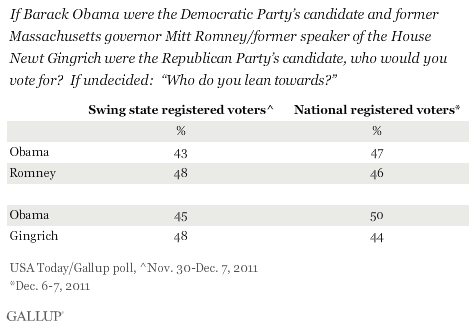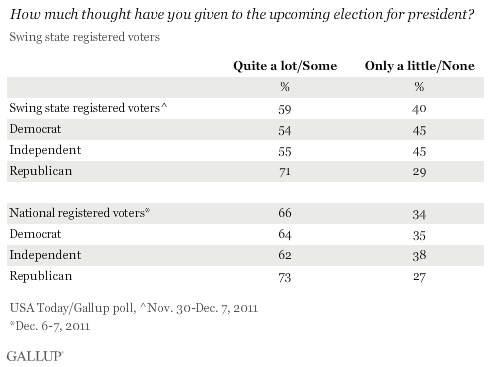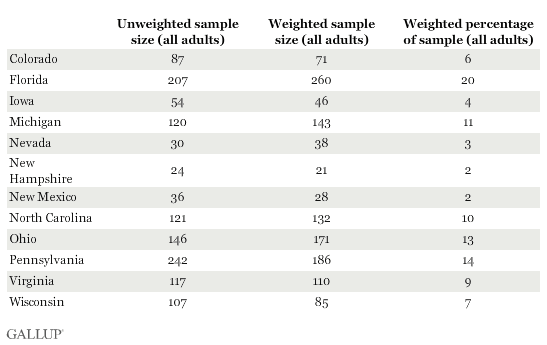PRINCETON, NJ -- Registered voters in 12 key swing states give a slight edge to the two leading Republican presidential candidates, Mitt Romney and Newt Gingrich, over Barack Obama as their preference for president in the 2012 election. Nationally, Obama fares somewhat better, essentially tying Romney and leading Gingrich by a six-percentage-point margin.

The "swing state" results are from the second USA Today/Gallup Swing States poll, based on Nov. 30-Dec. 7 Gallup Daily tracking of registered voters in 12 states that will be among the most crucial to winning the 2012 presidential election. The states include Colorado, Florida, Iowa, Michigan, Nevada, New Hampshire, New Mexico, North Carolina, Ohio, Pennsylvania, Virginia, and Wisconsin. The national results are based on Dec. 6-7 Gallup Daily tracking of registered voters.
These results continue to indicate a largely divided electorate 11 months before the Nov. 6 presidential vote and before the final GOP nominee is determined. But the slight edge for the GOP candidates in the 12 swing states is significant given that President Obama won each of these swing states in 2008 and will need to win a healthy percentage of them again to retain his office for a second term.
Republican preferences for their party's nominees have shifted significantly in recent weeks, as the previously high-flying Herman Cain faltered and then suspended his campaign, and as former House Speaker Gingrich vaulted to the GOP lead. Gingrich's rise is so new that Gallup did not include him in the initial USA Today/Gallup Swing States poll in October. However, Gallup did include Romney in the October poll who was, at the time, tied with Obama.
At the national level, the race between Obama and Romney has remained close and largely unchanged across four polls conducted in August, September, October, and now in December. These trends demonstrate that general election preferences at this point are stable, even as Republican Party preferences continue to churn.
Republicans Giving More Thought to Election so Far
Almost 6 in 10 registered voters in the 12 swing states have given "quite a lot" or "some" thought to the election at this point. However, registered voters nationally have given more thought to the election than voters in the swing states, perhaps surprisingly, given that the swing states are generally where the political action has been in previous elections and where it will be again in this election.

In both groups, Republicans have given significantly more thought to the election than Democrats or independents. This most likely reflects that Republicans are the "out" party in this year's election, and also may reflect the intense media focus on the Republican primary so far this year, compared with the absence of a primary on the Democratic side.
Majority Skeptical That Election Outcome Will Affect the Economy
The key issues in next year's presidential election almost certainly will be the economy and jobs. President Obama and the various Republican candidates are continually discussing their plans of action to improve both if elected next November.
At this point, however, Americans in the swing states and across the nation as a whole retain some skepticism that the outcome of the election will make a big difference to the economy. Forty-two percent of voters in the swing states and nationally say that whether a Democrat or a Republican is elected president in 2012 will make a major difference in terms of solving the country's economic problems, while the rest are split between the feeling that it will make a minor difference or no difference at all.

Republicans, however, are more inclined to think the party of the president elected next year will make a major difference, both in the swing states and nationally. Independents, as behooves their status as less firmly connected to the traditional political process, are the most cynical that the election outcome will affect the economy.
Bottom Line
It is too early in the 2012 election process to predict who will win the presidency next November, but the trial heat trend data so far this year suggest a close and stable race. At the national level, Obama and Romney have remained essentially tied since August, while Obama has a slight lead over Gingrich currently. Obama, however, slightly trails these two Republicans in the 12 key swing states, but in the broad sense, the race remains close in these states as well.
Republicans have given more thought to the election process so far in swing states and nationally, and they are more likely to say that who wins the election will make a difference to the country's ability to solve economic problems. This may reflect in part that Republicans have the only contested primary for the 2012 election. Whether Democrats start to focus more on the election once the Republican nominee is known will begin to give an indication of Democrats' ability to re-create the strong involvement they manifested in the 2008 election process.
Survey Methods
Results for swing state residents are based on telephone interviews conducted Nov. 30-Dec. 7, 2011, on the Gallup Daily tracking survey, with a random sample of 1,132 registered voters, aged 18 and older, living in Colorado, Florida, Iowa, Michigan, Nevada, New Hampshire, New Mexico, North Carolina, Ohio, Pennsylvania, Virginia, and Wisconsin, selected using random-digit-dial sampling.
For results based on the total sample of 1,132 registered voters in swing states, one can say with 95% confidence that the maximum margin of sampling error is ±4 percentage points.
The data represent a subset of Gallup's national daily tracking survey for Nov. 30-Dec. 7, and are proportionate to population size of each state. Samples are weighted by gender, age, race, Hispanic ethnicity, education, region, adults in the household, and phone status (cell phone only/landline only/both, cell phone mostly, and having an unlisted landline number). Demographic weighting targets are based on the March 2010 Current Population Survey figures for the aged 18 and older non-institutionalized population living in U.S. telephone households. All reported margins of sampling error include the computed design effects for weighting and sample design.
The weighted and unweighted sample sizes for each state are shown here:

Results for the national sample are based on telephone interviews conducted Dec. 6-7, 2011, on the Gallup Daily tracking survey, with a random sample of 883 registered voters, aged 18 and older, living in all 50 U.S. states and the District of Columbia.
For results based on the sample of registered voters, one can say with 95% confidence that the maximum margin of sampling error is ±4 percentage points.
Interviews are conducted with respondents on landline telephones and cellular phones, with interviews conducted in Spanish for respondents who are primarily Spanish-speaking. Each sample includes a minimum quota of 400 cell phone respondents and 600 landline respondents per 1,000 national adults, with additional minimum quotas among landline respondents by region. Landline telephone numbers are chosen at random among listed telephone numbers. Cell phone numbers are selected using random-digit-dial methods. Landline respondents are chosen at random within each household on the basis of which member had the most recent birthday.
Samples are weighted by gender, age, race, Hispanic ethnicity, education, region, adults in the household, and phone status (cell phone only/landline only/both, cell phone mostly, and having an unlisted landline number). Demographic weighting targets are based on the March 2010 Current Population Survey figures for the aged 18 and older non-institutionalized population living in U.S. telephone households. All reported margins of sampling error include the computed design effects for weighting and sample design.
In addition to sampling error, question wording and practical difficulties in conducting surveys can introduce error or bias into the findings of public opinion polls.
View methodology, full question results, and trend data.
For more details on Gallup's polling methodology, visit https://www.gallup.com/.
